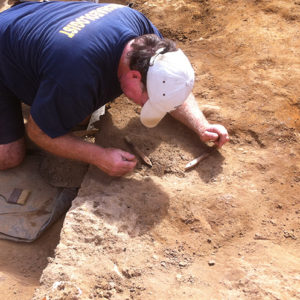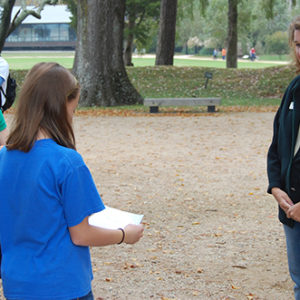October is a golden month for archaeology at James Fort. The high heat of the summer is gone but there is still warmth and sunshine. Student groups lend a playful energy. Archaeologists banter as they review the work already done and anticipate the finds that will come in the last days before winter.
All summer there had been an anticipation for discoveries out of the L-shaped cellar near the middle of James Fort.
After Jamestown Rediscovery archaeologists opened the feature in April, they found the lower leaf of an ivory pocket sundial known as a diptych dial, made in Nuremberg, Germany. Last month the cellar yielded a piece of bone inlay beautifully engraved with the figure of a 17th-century soldier holding a sword.
The warm, sunny days of October continued the steady pace of discovery. One day produced a rowel spur—the kind that features a small revolving wheel or disk with points on it (the rowel was corroded in place and did not turn at the time of excavation). Another day saw the removal of an unusually long, hollow piece of iron. And on one Thursday the archaeologists uncovered a copper coin or jetton, a locally-made pipe bowl, pieces of coal and clinker from iron working, and a Bartmann jug base with a large iron ring concreted to it.
And those were just some of the artifacts readily visible to the archaeologists working within the feature. Buckets of dirt removed from the feature for screening through fine mesh produced even more objects. The Thursday that the Bartmann jug base was found, volunteer George Evans of Maryland stood at a table by the seawall, pushing water and soil through the screen. He found the iron head of a hammer and a lead musket ball. Archaeologist Jamie May walked over to check his progress and showed these pieces to several visitors who walked to the seawall to see the waterscreening. “You are probably about the third one in 400 years to hold that musket ball,” she told the visitors as they marveled at it.
After that discussion by the seawall, May walked back to the cellar excavation. At this time of year school groups crisscross the fort site to add to their classroom studies of Jamestown and the early years of English settlement in Virginia. There is a constant hum of talking across the fort site. And suddenly fourth graders from Glen Allen Elementary near Richmond ran along the rope line above the L-shaped cellar. “THEY FOUND A BOOK!!!”
Jamestown Rediscovery conservator Dan Gamble had just spent 10 minutes freeing pieces of a book from the F layer of soil in the cellar—a dark vein of soil with a lot of organic material. The F layer has produced most of the artifacts from the cellar this summer—more than the other layers of soil combined.
Gamble walked along the rope line to show the students the remains of the book, which amounted to a copper alloy book clasp with bits of leather and cloth around it. Made of organic material, books usually deteriorate in dry soil, but in this case the copper gave off salts that slowed deterioration, Gamble said.
“We have found other leather artifacts before, but usually it’s not much,” Gamble said. “There’s a lot of the artifact missing here, too. Only the parts around the copper have survived. It’s rare to find stuff like this in a dry area.”
The students were excited to look at a historical object that reminded them of classroom materials they use today, but it was hard to see a book in the fragments that looked like dirt itself.
“You can tell what it is because of the consistency of the dirt around it. You can feel the difference. This is much lighter than normal soil,” Gamble said, as he took the book fragments to the Jamestown Rediscovery lab for conservation. Curator Bly Straube said that more than 100 copper alloy clasps from books have been found during the 19 seasons of the Jamestown Rediscovery project, but this is the first one that is still attached to the leather book strap.
But the F layer held more on this sunny afternoon. After Gamble went to the lab and the students continued on their tour, archaeologist Dan Smith continued to work in the area where Gamble had just freed the book fragments. Smith thought he spied another piece of leather. He moved soil away from it carefully with a small brush, then blew more dirt away with his mouth.
The archaeologists work so carefully because the context—where an artifact is found in the soil—gives a lot of information, archaeologist Don Warmke said.
“It’s not like other activities where if you make a mistake you can erase your paper. Once you dig the dirt out of the ground, you can’t put it back in. So we have to be meticulous when we dig.”
Groups continued to move to the rope line and move away as the archaeologists chatted and scraped in their own areas of the cellar. Smith got down to using a dental pick to make precise scrapes at the soil around the fragment he found.
After about 20 minutes, Smith had another artifact freed and onto a dustpan for carrying to the lab. Smith’s piece turned out to be a long strip of the leather kept in surprisingly good condition by its charring in a fire.
The F layer may have come from a common trash pile that mixed ashes and trash in the middle of the fort at a time when colonists were too busy with survival to dispose of trash. It could have been used to fill the cellar as part of a fort cleanup ordered in 1610. The cellar is 25 feet long and dates to the early James Fort period (1607-1610) and aligns with James Fort’s first well, which sits 10 feet away to the west and at the same angle.
More answers will come with more investigation. And the project will continue because of contributions like the one brought to the Jamestown Rediscovery staff the day after the discovery of the book fragments. About 140 students from the Mountain Island Charter School in Mount Holly, NC, toured the James Fort site and handed $140 to May to keep the dig going.
related images
- Archaeologist Dan Smith Excavating Book Leather from Structure 191
- Archaeologist Jamie May Accepting Donation from Mountain Island Charter School Students
- Using a pick to excavate an artifact in the unit wall








